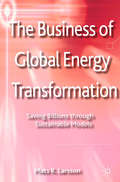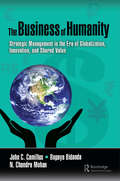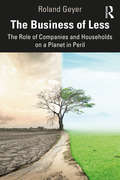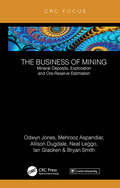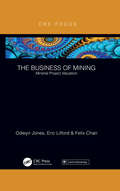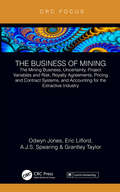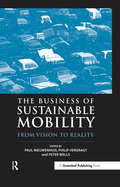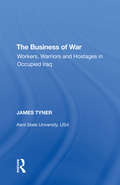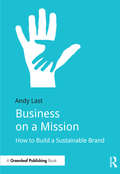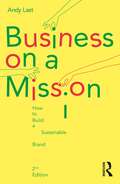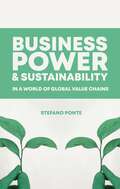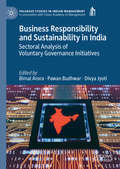- Table View
- List View
The Business of Global Energy Transformation: Saving Billions through Sustainable Models
by M. LarssonOne of the first books to analyze business and financial aspects of sustainable transport and fuels systems and provides novel insights for researchers, managers, and politicians who work in energy and sustainability related areas.
The Business of Humanity: Strategic Management in the Era of Globalization, Innovation, and Shared Value
by John Camillus Bopaya Bidanda N. Chandra MohanCompanies across the world, for a variety of reasons, are committing to incorporating social responsibility into their business models and finding that their profits are growing and their long-term sustainability is enhanced—building "humanity" into their business models as the driver of economic, environmental, and social sustainability. This fascinating development is a widely observable global phenomenon. The "Business of Humanity®" (BoH) Proposition is the synthesis of counter-intuitive but simple and powerful ideas about how companies can add value in today’s globalized and fast-changing world. The task of BoH Strategies is to overcome three critical challenges characterizing today’s business environment, namely disruptive technologies, conflicted stakeholders, and unknowable futures. BoH Strategies are designed to convert these challenges into opportunities for enhanced sustainability on all three dimensions—economic, environmental and social. Written by leading experts with decades of experience, this book: Provides a hands-on understanding of how to implement this powerful and rewarding approach to simultaneously add economic value and enhance social benefit Includes the experiences and approaches of highly regarded business executives and successful organizations Responds to the critical challenges created by three environmental mega forces – the inevitability of globalization, the imperative of innovation, and the importance of shared value. This book is based on lessons drawn from the real world and provides a compelling rationale for the power of the BoH Proposition. The pragmatic framework and process offered enable companies to develop and confidently implement value-adding strategies based on the BoH Proposition.
The Business of Humanity: Strategic Management in the Era of Globalization, Innovation, and Shared Value
by John Camillus Bopaya Bidanda N. Chandra MohanCompanies across the world, for a variety of reasons, are committing to incorporating social responsibility into their business models and finding that their profits are growing and their long-term sustainability is enhanced—building "humanity" into their business models as the driver of economic, environmental, and social sustainability. This fascinating development is a widely observable global phenomenon. The "Business of Humanity®" (BoH) Proposition is the synthesis of counter-intuitive but simple and powerful ideas about how companies can add value in today’s globalized and fast-changing world. The task of BoH Strategies is to overcome three critical challenges characterizing today’s business environment, namely disruptive technologies, conflicted stakeholders, and unknowable futures. BoH Strategies are designed to convert these challenges into opportunities for enhanced sustainability on all three dimensions—economic, environmental and social. Written by leading experts with decades of experience, this book: Provides a hands-on understanding of how to implement this powerful and rewarding approach to simultaneously add economic value and enhance social benefit Includes the experiences and approaches of highly regarded business executives and successful organizations Responds to the critical challenges created by three environmental mega forces – the inevitability of globalization, the imperative of innovation, and the importance of shared value. This book is based on lessons drawn from the real world and provides a compelling rationale for the power of the BoH Proposition. The pragmatic framework and process offered enable companies to develop and confidently implement value-adding strategies based on the BoH Proposition.
The Business of Less: The Role of Companies and Households on a Planet in Peril
by Roland GeyerThe Business of Less rewrites the book on business and the environment. For the last thirty years, corporate sustainability was synonymous with the pursuit of ‘eco-efficiency’ and ‘win-win’ opportunities. The notion of ‘eco-efficiency’ gives us the illusion that we can achieve environmental sustainability without having to question the pursuit of never-ending economic growth. The ‘win-win’ paradigm is meant to assure us that companies can be protectors of the environment whilst also being profit maximizers. It is abundantly clear that the state of the natural environment has further degraded instead of improved. This book introduces a new paradigm designed to finally reconcile business and the environment. It is called ‘net green’, which means that in these times of ecological overshoot businesses need to reduce total environmental impact and not just improve the eco-efficiency of their products. The book also introduces and explains the four pollution prevention principles ‘again’, ‘different’, ‘less’, and ‘labor, not materials’. Together, ‘net green’ and the four pollution prevention principles provide a road map, for businesses and for every household, to a world in which human prosperity and a healthy environment are no longer at odds. The Business of Less is full of anecdotes and examples. This brings its material to life and makes the book not only very accessible, but also hugely applicable for everyone who is worried about the fate of our planet and is looking for answers.
The Business of Less: The Role of Companies and Households on a Planet in Peril
by Roland GeyerThe Business of Less rewrites the book on business and the environment. For the last thirty years, corporate sustainability was synonymous with the pursuit of ‘eco-efficiency’ and ‘win-win’ opportunities. The notion of ‘eco-efficiency’ gives us the illusion that we can achieve environmental sustainability without having to question the pursuit of never-ending economic growth. The ‘win-win’ paradigm is meant to assure us that companies can be protectors of the environment whilst also being profit maximizers. It is abundantly clear that the state of the natural environment has further degraded instead of improved. This book introduces a new paradigm designed to finally reconcile business and the environment. It is called ‘net green’, which means that in these times of ecological overshoot businesses need to reduce total environmental impact and not just improve the eco-efficiency of their products. The book also introduces and explains the four pollution prevention principles ‘again’, ‘different’, ‘less’, and ‘labor, not materials’. Together, ‘net green’ and the four pollution prevention principles provide a road map, for businesses and for every household, to a world in which human prosperity and a healthy environment are no longer at odds. The Business of Less is full of anecdotes and examples. This brings its material to life and makes the book not only very accessible, but also hugely applicable for everyone who is worried about the fate of our planet and is looking for answers.
The Business of Mining: Mineral Deposits, Exploration and Ore-Reserve Estimation (Volume 3) (The Business of Mining)
by Ifan Odwyn Jones Mehrooz Aspandiar Allison Dugdale Neal Leggo Ian Glacken Bryan SmithThe Business of Mining complete set of three Focus books provides readers with a holistic all-embracing appraisal of the analytical tools available for assessing the economic viability of prospective mines. Each volume has a discrete focus. This third volume commences with "Our Earth, its Minerals and Ore Bodies", followed by a review of mineral exploration and sampling of mineral deposits. It continues with detailed sections covering the reporting of mineral resources and reserves in Australia, and concludes with the basic principles and application of the various methods of estimating the in-situ mineral resources and ore reserves. The books were written primarily for undergraduate applied geologists, mining engineers and extractive metallurgists and those pursuing course-based postgraduate programs in mineral economics. However, the complete series will also be an extremely useful reference text for practicing mining professionals as well as for consultant geologists, mining engineers or primary metallurgists.
The Business of Mining: Mineral Deposits, Exploration and Ore-Reserve Estimation (Volume 3) (The Business of Mining)
by Ifan Odwyn Jones Mehrooz Aspandiar Allison Dugdale Neal Leggo Ian Glacken Bryan SmithThe Business of Mining complete set of three Focus books provides readers with a holistic all-embracing appraisal of the analytical tools available for assessing the economic viability of prospective mines. Each volume has a discrete focus. This third volume commences with "Our Earth, its Minerals and Ore Bodies", followed by a review of mineral exploration and sampling of mineral deposits. It continues with detailed sections covering the reporting of mineral resources and reserves in Australia, and concludes with the basic principles and application of the various methods of estimating the in-situ mineral resources and ore reserves. The books were written primarily for undergraduate applied geologists, mining engineers and extractive metallurgists and those pursuing course-based postgraduate programs in mineral economics. However, the complete series will also be an extremely useful reference text for practicing mining professionals as well as for consultant geologists, mining engineers or primary metallurgists.
The Business of Mining: Mineral Project Valuation (The Business of Mining)
by Odwyn Jones Eric Lilford Felix ChanThe Business of Mining complete set of three Focus books will provide readers with a holistic all-embracing appraisal of the analytical tools available for assessing the economic viability of prospective mines. Each volume has a discrete focus. This second volume discusses, in some depth, alternative means of assessing the economic viability of mining projects based on the best estimate of the recoverable mineral and/or fossil fuel reserves. The books were written primarily for undergraduate applied geologists, mining engineers and extractive metallurgists and those pursuing course-based postgraduate programs in mineral economics. However, the complete series will also be an extremely useful reference text for practicing mining professionals as well as for consultant geologists, mining engineers or primary metallurgists.
The Business of Mining: Mineral Project Valuation (The Business of Mining)
by Odwyn Jones Eric Lilford Felix ChanThe Business of Mining complete set of three Focus books will provide readers with a holistic all-embracing appraisal of the analytical tools available for assessing the economic viability of prospective mines. Each volume has a discrete focus. This second volume discusses, in some depth, alternative means of assessing the economic viability of mining projects based on the best estimate of the recoverable mineral and/or fossil fuel reserves. The books were written primarily for undergraduate applied geologists, mining engineers and extractive metallurgists and those pursuing course-based postgraduate programs in mineral economics. However, the complete series will also be an extremely useful reference text for practicing mining professionals as well as for consultant geologists, mining engineers or primary metallurgists.
The Business of Mining: The Mining Business, Uncertainty, Project Variables and Risk, Royalty Agreements, Pricing and Contract Systems, and Accounting for the Extractive Industry (The Business of Mining)
by Odwyn Jones Eric Lilford Sam Spearing Grantley TaylorThe Business of Mining complete set of three Focus books will provide readers with a holistic all-embracing appraisal of the analytical tools available for assessing the economic viability of prospective mines. Each volume has a discrete focus. This first volume presents an overview of the mining business, followed by an analysis of project variables and risk, an overall coverage of the royalty agreements, pricing and contract systems followed by a final chapter on accounting standards and practises for the minerals industry. The books were written primarily for undergraduate applied geologists, mining engineers and extractive metallurgists and those pursuing course-based postgraduate programs in mineral economics. However, the complete series will also be an extremely useful reference text for practicing mining professionals as well as for consultant geologists, mining engineers or primary metallurgists.
The Business of Mining: The Mining Business, Uncertainty, Project Variables and Risk, Royalty Agreements, Pricing and Contract Systems, and Accounting for the Extractive Industry (The Business of Mining)
by Odwyn Jones Eric Lilford Sam Spearing Grantley TaylorThe Business of Mining complete set of three Focus books will provide readers with a holistic all-embracing appraisal of the analytical tools available for assessing the economic viability of prospective mines. Each volume has a discrete focus. This first volume presents an overview of the mining business, followed by an analysis of project variables and risk, an overall coverage of the royalty agreements, pricing and contract systems followed by a final chapter on accounting standards and practises for the minerals industry. The books were written primarily for undergraduate applied geologists, mining engineers and extractive metallurgists and those pursuing course-based postgraduate programs in mineral economics. However, the complete series will also be an extremely useful reference text for practicing mining professionals as well as for consultant geologists, mining engineers or primary metallurgists.
The Business of Sustainable Mobility: From Vision to Reality
by Peter Wells Paul Nieuwenhuis Philip VergragtIn many parts of the world, there is a crisis of mobility. The choices we have made over the past 200 years on modes and technologies of transport have brought us unprecedented global interaction and in many respects increased personal freedom. However, all this mobility has come at a cost to society, to the economy and to the environment. Mobility is in crisis, but few seem aware of the full extent of it. Though most people will be aware of congestion, accidents (although this aspect is often overlooked), parking restrictions or fuel prices, few will have considered the effects of the dramatic increase in mobility expected in China, India and elsewhere. Nor do many people in their daily lives consider the impact of climate change on our environment and the contribution our cars make to it. It is often thought that technology alone can solve this problem. For some observers, salvation could be achieved by means of hydrogen fuel cells, by hybrid cars, or by increased fuel efficiency, or even by telematics to reduce congestion. This book shows that "technology" may well not be enough in itself and that for a genuinely sustainable transport future far more radical change – affecting many aspects of society – is needed. It is likely, for example, that new business models are needed, as well as users and consumers adopting new forms of behaviour. Disruptive technological innovation may well contribute, but needs to be induced by a combination of market forces and government regulation.Many studies touch on transport and mobility issues and more mainstream books aimed at challenging the dominance of automobility are common, yet works dealing with the longer-term strategic, theoretical and broader conceptual issues needed to inform the move towards more sustainable transport are rare. Yet policy-makers, practitioners, as well as many sections of academia, acknowledge a need for guidance on new thinking on sustainable mobility. This book brings together a range of views representing both leading-edge thinking and best practice in the mobility sector. The individual expert contributions form the basis for framing a broader vision of future mobility and proposed transition trajectories towards that future.Much of the effort reflected in the chapters in this book is concerned with going beyond the "technofix" of new cars, to confront the more difficult challenges of institutional, cultural and social change within and beyond the industry that have to be resolved in the transition towards sustainability. It therefore seeks to break through the conventional boundary between engineering and the social sciences, and the contributors come from both sides of this traditional but unnecessary divide, combining economists, engineers, geographers, designers and others.The work is based on the sustainable mobility stream in the 2003 International Greening of Industry Network conference in San Francisco. This event brought together experts from industry and government, and the book combines some of the papers presented there, developed and updated into full chapters, with a number of additional chapters to capture some of the themes that emerged from the conference.The central problem addressed in this book is the private car: how to power it, how to build it and how to deliver it to customers in a more sustainable future. It starts with ideas of radical innovation in the propulsion system of the car, notably the hydrogen fuel cell. In one section, the book examines business models that could be used to deliver automobility in a more sustainable manner. This section looks at how the car is made and used, and looks beyond it by examining how we could change those aspects in our quest for sustainable mobility. The book then considers a number of recently introduced vehicles and alternative vehicle concepts within the context of a dominant existing paradigm. These vary from a minimalist single-seat commuter to a powertrain exchange concept that could breathe new life into the electric vehicle. A number of chapters then report on current practice
The Business of Sustainable Mobility: From Vision to Reality
by Peter Wells Paul Nieuwenhuis Philip VergragtIn many parts of the world, there is a crisis of mobility. The choices we have made over the past 200 years on modes and technologies of transport have brought us unprecedented global interaction and in many respects increased personal freedom. However, all this mobility has come at a cost to society, to the economy and to the environment. Mobility is in crisis, but few seem aware of the full extent of it. Though most people will be aware of congestion, accidents (although this aspect is often overlooked), parking restrictions or fuel prices, few will have considered the effects of the dramatic increase in mobility expected in China, India and elsewhere. Nor do many people in their daily lives consider the impact of climate change on our environment and the contribution our cars make to it. It is often thought that technology alone can solve this problem. For some observers, salvation could be achieved by means of hydrogen fuel cells, by hybrid cars, or by increased fuel efficiency, or even by telematics to reduce congestion. This book shows that "technology" may well not be enough in itself and that for a genuinely sustainable transport future far more radical change – affecting many aspects of society – is needed. It is likely, for example, that new business models are needed, as well as users and consumers adopting new forms of behaviour. Disruptive technological innovation may well contribute, but needs to be induced by a combination of market forces and government regulation.Many studies touch on transport and mobility issues and more mainstream books aimed at challenging the dominance of automobility are common, yet works dealing with the longer-term strategic, theoretical and broader conceptual issues needed to inform the move towards more sustainable transport are rare. Yet policy-makers, practitioners, as well as many sections of academia, acknowledge a need for guidance on new thinking on sustainable mobility. This book brings together a range of views representing both leading-edge thinking and best practice in the mobility sector. The individual expert contributions form the basis for framing a broader vision of future mobility and proposed transition trajectories towards that future.Much of the effort reflected in the chapters in this book is concerned with going beyond the "technofix" of new cars, to confront the more difficult challenges of institutional, cultural and social change within and beyond the industry that have to be resolved in the transition towards sustainability. It therefore seeks to break through the conventional boundary between engineering and the social sciences, and the contributors come from both sides of this traditional but unnecessary divide, combining economists, engineers, geographers, designers and others.The work is based on the sustainable mobility stream in the 2003 International Greening of Industry Network conference in San Francisco. This event brought together experts from industry and government, and the book combines some of the papers presented there, developed and updated into full chapters, with a number of additional chapters to capture some of the themes that emerged from the conference.The central problem addressed in this book is the private car: how to power it, how to build it and how to deliver it to customers in a more sustainable future. It starts with ideas of radical innovation in the propulsion system of the car, notably the hydrogen fuel cell. In one section, the book examines business models that could be used to deliver automobility in a more sustainable manner. This section looks at how the car is made and used, and looks beyond it by examining how we could change those aspects in our quest for sustainable mobility. The book then considers a number of recently introduced vehicles and alternative vehicle concepts within the context of a dominant existing paradigm. These vary from a minimalist single-seat commuter to a powertrain exchange concept that could breathe new life into the electric vehicle. A number of chapters then report on current practice
The Business of War: Workers, Warriors and Hostages in Occupied Iraq
by James A. TynerSince the cessation of major combat operations in Iraq, approximately 120 people - either contract workers or private soldiers - have been abducted, with one-third being executed. The largest contingent of these workers has been provided by the Philippines. Through a specific, though not exclusive, focus on the Philippines connection, this book considers the myriad ways in which transnational labour migration intersects with the occupation of Iraq. Also examining the role of the USA in the Middle East, the book places the war on terror within the practices of neoliberalism, but also links this with migration issues and argues that it is all part of a larger 'business' of conflict.
The Business of War: Workers, Warriors and Hostages in Occupied Iraq
by James A. TynerSince the cessation of major combat operations in Iraq, approximately 120 people - either contract workers or private soldiers - have been abducted, with one-third being executed. The largest contingent of these workers has been provided by the Philippines. Through a specific, though not exclusive, focus on the Philippines connection, this book considers the myriad ways in which transnational labour migration intersects with the occupation of Iraq. Also examining the role of the USA in the Middle East, the book places the war on terror within the practices of neoliberalism, but also links this with migration issues and argues that it is all part of a larger 'business' of conflict.
Business on a Mission: How to Build a Sustainable Brand
by Andy LastBronze winner of the AXIOM Business Book Award in the category of Philanthropy, Non-Profit, Sustainability. Please see: http://www.axiomawards.com/77/award-winners/2017-winners This easy-to-read and engaging book is the perfect introduction to how to build a sustainable brand for your organization. Intended as a roadmap that can be readily applied by busy managers and practitioners, the book includes interviews with business leaders, including Paul Polman of Unilever, Adam Elman of Marks & Spencer, and Jonas Prising of ManpowerGroup to provide insight into best practice and clear guidance for implementation. Throughout, the book avoids jargon and theorizing to ensure readability. Business on a Mission is based on more than a decade working with some of the first businesses to develop social missions and shows the foundations behind their success. It looks at how businesses can profit from working hand in hand with society and identifies a model for success. The book demonstrates how businesses can go from hiding behind "social shields" to picking up "social swords" and presents the six criteria to look for in assessing a social mission. It also focuses on how good communications can build trust and bring about positive change; and it provides clear ways to engage employees and improve productivity as well as "rules" for communicating social missions externally. This optimistic book explains the benefits of partnerships in the sustainable development agenda, particularly between businesses and NGOs. The book features guidelines for avoiding dysfunctional partnerships, and presents interviews with Marc Van Ameringen, Executive Director of GAIN (Global Alliance for Improved Nutrition) 2005 to 2016, and Myriam Sidibe, Social Mission Director for Africa, Unilever, on how things can be managed to the benefit of both partners. .
Business on a Mission: How to Build a Sustainable Brand
by Andy LastBronze winner of the AXIOM Business Book Award in the category of Philanthropy, Non-Profit, Sustainability. Please see: http://www.axiomawards.com/77/award-winners/2017-winners This easy-to-read and engaging book is the perfect introduction to how to build a sustainable brand for your organization. Intended as a roadmap that can be readily applied by busy managers and practitioners, the book includes interviews with business leaders, including Paul Polman of Unilever, Adam Elman of Marks & Spencer, and Jonas Prising of ManpowerGroup to provide insight into best practice and clear guidance for implementation. Throughout, the book avoids jargon and theorizing to ensure readability. Business on a Mission is based on more than a decade working with some of the first businesses to develop social missions and shows the foundations behind their success. It looks at how businesses can profit from working hand in hand with society and identifies a model for success. The book demonstrates how businesses can go from hiding behind "social shields" to picking up "social swords" and presents the six criteria to look for in assessing a social mission. It also focuses on how good communications can build trust and bring about positive change; and it provides clear ways to engage employees and improve productivity as well as "rules" for communicating social missions externally. This optimistic book explains the benefits of partnerships in the sustainable development agenda, particularly between businesses and NGOs. The book features guidelines for avoiding dysfunctional partnerships, and presents interviews with Marc Van Ameringen, Executive Director of GAIN (Global Alliance for Improved Nutrition) 2005 to 2016, and Myriam Sidibe, Social Mission Director for Africa, Unilever, on how things can be managed to the benefit of both partners. .
Business on a Mission: How to Build a Sustainable Brand
by Andy LastBusiness on a Mission is a simple to follow guide for how organisations can adapt to the changing world and evolving expectations of stakeholders to build more purpose-led, sustainable businesses. It features proven models and case study examples of how to create a brand that talks to the emerging Gen Z consumer base; how to use social missions to drive sales in retail and with B2B customers; how to preserve reputation and licence to operate by working in partnership with not-for-profit organisations; and how to attract and retain the best talent by demonstrating a genuine social purpose. As well as clear, applicable models and behind-the-scenes descriptions of how successful campaigns were built and sustainable change made, this book features candid interviews with change makers from the worlds of retail, professional services, consumer goods, and NGOs. This second edition looks at how businesses and brands like Dove are now linking social and environmental goals, with an exclusive interview with Unilever CEO, Alan Jope. It explores how investors are now driving a systemic change in focus in the boardroom towards the sustainability agenda, and how leaders can respond to this, featuring a new interview with Frank Cooper, Global Chief Marketing Officer and member of the Global Executive Committee at BlackRock. The impact of the pandemic on what it means to be a sustainable brand, including a focus on sustainable supply chains, the growing power of Gen Z, the growth of online purchasing, multi-stakeholder partnerships, increased regulation, and culture at work, is also explored. This book has been read, enjoyed, and used by business leaders to identify models for change; by managers to create progressive campaigns; by NGOs to create stronger partnerships with the private sector; and by students to learn how theories of social purpose and sustainability can be applied in the real world. The first edition was Bronze winner of the AXIOM Business Book Award in the category of Philanthropy, Non-Profit, Sustainability.
Business on a Mission: How to Build a Sustainable Brand
by Andy LastBusiness on a Mission is a simple to follow guide for how organisations can adapt to the changing world and evolving expectations of stakeholders to build more purpose-led, sustainable businesses. It features proven models and case study examples of how to create a brand that talks to the emerging Gen Z consumer base; how to use social missions to drive sales in retail and with B2B customers; how to preserve reputation and licence to operate by working in partnership with not-for-profit organisations; and how to attract and retain the best talent by demonstrating a genuine social purpose. As well as clear, applicable models and behind-the-scenes descriptions of how successful campaigns were built and sustainable change made, this book features candid interviews with change makers from the worlds of retail, professional services, consumer goods, and NGOs. This second edition looks at how businesses and brands like Dove are now linking social and environmental goals, with an exclusive interview with Unilever CEO, Alan Jope. It explores how investors are now driving a systemic change in focus in the boardroom towards the sustainability agenda, and how leaders can respond to this, featuring a new interview with Frank Cooper, Global Chief Marketing Officer and member of the Global Executive Committee at BlackRock. The impact of the pandemic on what it means to be a sustainable brand, including a focus on sustainable supply chains, the growing power of Gen Z, the growth of online purchasing, multi-stakeholder partnerships, increased regulation, and culture at work, is also explored. This book has been read, enjoyed, and used by business leaders to identify models for change; by managers to create progressive campaigns; by NGOs to create stronger partnerships with the private sector; and by students to learn how theories of social purpose and sustainability can be applied in the real world. The first edition was Bronze winner of the AXIOM Business Book Award in the category of Philanthropy, Non-Profit, Sustainability.
Business on the Edge: How to Turn a Profit and Improve Lives in the World's Toughest Places
by Viva Ona Bartkus Emily S. BlockA road map for how businesses can grow and make money while reducing poverty and conflict in some of the world&’s most challenging environments Many companies worry that expanding into emerging markets is a risky—and even dangerous—move. Professors Viva Ona Bartkus and Emily S. Block see things differently. They argue that by entering markets in the world&’s frontline regions—areas stuck in cycles of violence and extreme poverty—businesses can actually create stability and expand opportunity for communities and corporations alike. From helping Colombian farmers transition from growing coca to produce to disrupting human trafficking rings by creating more construction jobs in the Philippines, Business on the Edge proves that businesses can make money while advancing corporate social responsibility, environmental conservation, and social justice. Partnering with groups including multinational companies, NGOs, and the US military, Bartkus and Block outline their process for generating opportunities, detailing their successes and failures in launching over eighty growth-oriented business solutions in thirty countries. Bridging the gap between academic research and real-world experience, Business on the Edge shows how businesses can reduce risks, cut costs, and increase profits, all while creating economic opportunities that transform communities.
Business, Peacebuilding, and Regulation: The Role of the State (Business and Peacebuilding)
by Sean MolloyThis book examines the relationship between business-based peacebuilding and the opportunities that emerge from the pluralisation of regulation. The core message is, notwithstanding the broad range of regulatory initiatives and actors that exist in conflict-affected settings, the state should assume responsibilities for defining the types of contribution that business can and ought to make to peace. It also demonstrates how the state, through different forms and methods of regulation, is well-placed to engage businesses to do so. It is particularly concerned with the potential for regulation to help address what is identified as a state of optimistic uncertainty in the field of business and peacebuilding. On one level, there is a sense of optimism around the types of contributions that businesses can and often do make as agents for peace. On another, there are varying degrees of uncertainty surrounding the actual peacebuilding impacts of business activities; how businesses are to understand the ways in which to make these contributions, and why businesses would do so. Regulation, this book will argue, can play an important role in bridging the chasm between optimism and uncertainty. This book will be of interest to those engaged not only with business and peacebuilding but also business and human rights, business and development and business and the environment. Moreover, this book is also of contemporary interest in other ways – the aftermath of the Ukranian conflict, as an example, will require a concerted effort to rebuild that society after war. Private sector actors could be a powerful vehicle for reconstruction and development and this book examines how regulation can be used to facilitate businesses involvement in peacebuilding efforts.
Business, Peacebuilding, and Regulation: The Role of the State (Business and Peacebuilding)
by Sean MolloyThis book examines the relationship between business-based peacebuilding and the opportunities that emerge from the pluralisation of regulation. The core message is, notwithstanding the broad range of regulatory initiatives and actors that exist in conflict-affected settings, the state should assume responsibilities for defining the types of contribution that business can and ought to make to peace. It also demonstrates how the state, through different forms and methods of regulation, is well-placed to engage businesses to do so. It is particularly concerned with the potential for regulation to help address what is identified as a state of optimistic uncertainty in the field of business and peacebuilding. On one level, there is a sense of optimism around the types of contributions that businesses can and often do make as agents for peace. On another, there are varying degrees of uncertainty surrounding the actual peacebuilding impacts of business activities; how businesses are to understand the ways in which to make these contributions, and why businesses would do so. Regulation, this book will argue, can play an important role in bridging the chasm between optimism and uncertainty. This book will be of interest to those engaged not only with business and peacebuilding but also business and human rights, business and development and business and the environment. Moreover, this book is also of contemporary interest in other ways – the aftermath of the Ukranian conflict, as an example, will require a concerted effort to rebuild that society after war. Private sector actors could be a powerful vehicle for reconstruction and development and this book examines how regulation can be used to facilitate businesses involvement in peacebuilding efforts.
Business, Power and Sustainability in a World of Global Value Chains
by Stefano PonteThe interaction of sustainability governance and global value chains has crucial implications the world over. When it comes to sustainability the last decade has witnessed the birth of hybrid forms of governance where business, civil society and public actors interact at different levels, leading to a focus on concepts of legitimacy within multi-stakeholder initiatives (MSIs).Based in over 15 years of theoretical engagement and field research, Business, Power and Sustainability draws from both labour-intensive value chains, such as in the agro-food sector (coffee, wine, fish, biofuels, palm oil), and from capital-intensive value chains such as in shipping and aviation, to discuss how sustainability governance can be best designed, managed and institutionalized in today's world of global value chains (GVCs). Examining current theoretical and analytical efforts aimed at including sustainability issues in GVC governance theory, it expands on recent work examining GVC upgrading by introducing the concept of environmental upgrading; and through new conceptions of orchestration, it provides suggestions for how governments and international organizations can best facilitate the achievement of sustainability goals.Essential reading on the governance of sustainability in the twenty-first century.
Business, Power and Sustainability in a World of Global Value Chains
by Stefano PonteThe interaction of sustainability governance and global value chains has crucial implications the world over. When it comes to sustainability the last decade has witnessed the birth of hybrid forms of governance where business, civil society and public actors interact at different levels, leading to a focus on concepts of legitimacy within multi-stakeholder initiatives (MSIs).Based in over 15 years of theoretical engagement and field research, Business, Power and Sustainability draws from both labour-intensive value chains, such as in the agro-food sector (coffee, wine, fish, biofuels, palm oil), and from capital-intensive value chains such as in shipping and aviation, to discuss how sustainability governance can be best designed, managed and institutionalized in today's world of global value chains (GVCs). Examining current theoretical and analytical efforts aimed at including sustainability issues in GVC governance theory, it expands on recent work examining GVC upgrading by introducing the concept of environmental upgrading; and through new conceptions of orchestration, it provides suggestions for how governments and international organizations can best facilitate the achievement of sustainability goals.Essential reading on the governance of sustainability in the twenty-first century.
Business Responsibility and Sustainability in India: Sectoral Analysis of Voluntary Governance Initiatives (Palgrave Studies in Indian Management)
by Bimal Arora Pawan Budhwar Divya JyotiOn the backdrop of the institutionalisation of corporate social responsibility (CSR) and sustainability, and the emergence of multi-stakeholder-driven voluntary regulation, this timely collection places special emphasis on India and explores its international voluntary sustainability standards. The authors analyse the adoption and implementation of voluntary governance initiatives across a range of industries, offering insightful sectoral discussion and evaluation of voluntary sustainability standards as forms of transnational private regulation. This book will be of interest to anyone researching CSR, sustainability and supply chain management in emerging markets.
